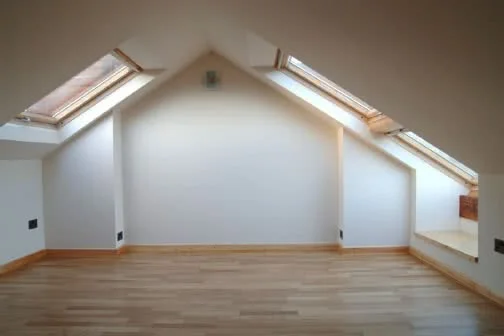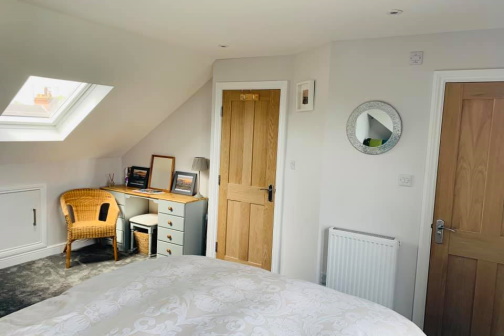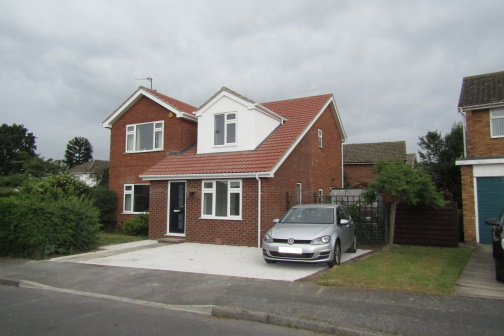Looking for a loft conversion in Bristol, Bath, or anywhere else in the area? CK Architectural can help
Choosing the Right Loft Conversion Type
Dormer conversions – A dormer loft conversion is an extension that protrudes from the slope of the roof and is one of the most commonly chosen loft conversion types in Bristol or Bath. Dormer conversions are less expensive than mansard or hip-to-gable conversions but will still add a good deal of extra headroom and floor space at the same time. Most houses with a sloping roof will be suitable for a dormer conversion.
Roof light conversions – These conversions are by far the cheapest and least disruptive option. This is because you won’t have to make any changes to the pitch or the shape of the roof. To make it a habitable room, all you need to do is add skylight windows, lay down a proper floor, and add a staircase. The only downside to this type of conversion is that you have to make sure you have enough headspace already in the loft, but we’ll work with you the ensure the most practical build possible.
Hip-to-gable conversions – This type of conversion will only work on detached, semi detached or bungalow properties. It requires a free sloping side roof, which by extending the sloping ‘hip’ roof at the side of your property outwards, will create a vertical ‘gable’ wall. This will make more internal headroom and is one of the most spacious loft conversion types as a result.
Design considerations
The main factors that determine if your loft can be converted successfully are the available head height, the pitch and the type of structure. Other considerations will be in areas like the position of the chimney breast, water tanks, and other features from elsewhere in the property, but they are rarely as impactful as the space you have to work with.
After this, you need to think about the facilities you need too. Ensuites need some special considerations for example, and so do rooms that may need to hold more weight.
With a simple inspection of the roof space, we will be able to let you know if your roof can be converted and exactly what’s available to you. Most homes in the UK do have available space in the loft for conversion just waiting to be utilised, and we’re highly experienced with all forms of loft conversion in Bristol and Bath, and will always give you the best advice for your personal situation.
Planning permission
The majority of loft conversions that we work with in Bristol and Bath will not need planning permission and will be covered by permitted development rights (see below).
When planning is required, however, the roof will need to fit in with the rest of the street, but there are other factors that also need to be considered along with this.
We will be able to advise you if you need planning permission or not and always work with you to make sure you have all the knowledge and advice you will need before you make any commitments.
CK Architectural
Contact us today to discuss all your project needs
Loft conversion permitted development rules
1. No extension beyond the plane of the existing roof slope of the principal elevation that fronts the highway.
2. No extension to be higher than the highest part of the roof and similar materials.
3. No verandas, balconies or raised platforms.
4. Side-facing windows to be obscure-glazed; any opening to be 1.7m above the floor.
5. Roof extensions, apart from hip to gable ones, to be set back at least 20cm from the original eaves.
6. The roof enlargement cannot overhang the outer face of the wall of the original house.
7. Roof extensions not to be permitted development in designated areas such as AONB (area of outstanding natural beauty), conservation areas, listed building etc.
Building regulations
Legally, Building Control need to be involved when altering the structure of a roof and building certificate required for the re sale or insuring of your property.
When creating habitable rooms like bedrooms, it is more than the structural integrity that will need upgrading. When designing a roof, your architect or architectural designer must consider the following:
- Structure, the new floor joists and roof will need to be supported; this is generally done via steel beams designed by an engineer.
- A protected fire route must be provided, this is 30 minutes all the way down to the final exit, existing doors will need upgrading to fire doors.
- Detection and sounded alarms will be required and need to be interlinked.
- The stairs will need sufficient headroom 2.0M and not be too steep (under 42 degrees).
- Reasonable sound insulation between the conversion and the rooms below
All the designs we present to you will be with the intention of passing building regulations and construct able. Take a look at our Building Regulations Guide.









